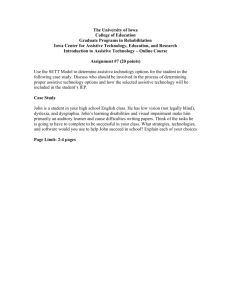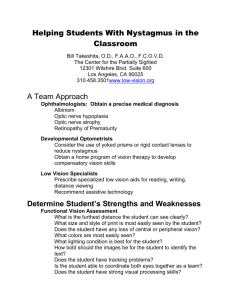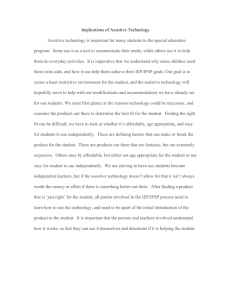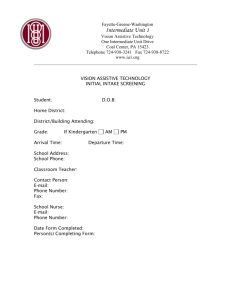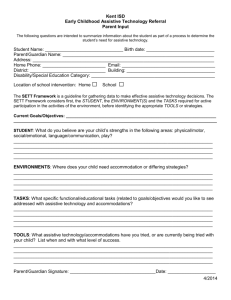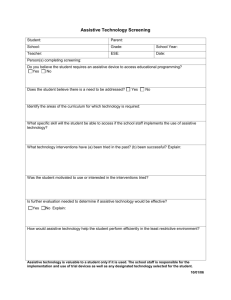Assistive Technology - exc
advertisement
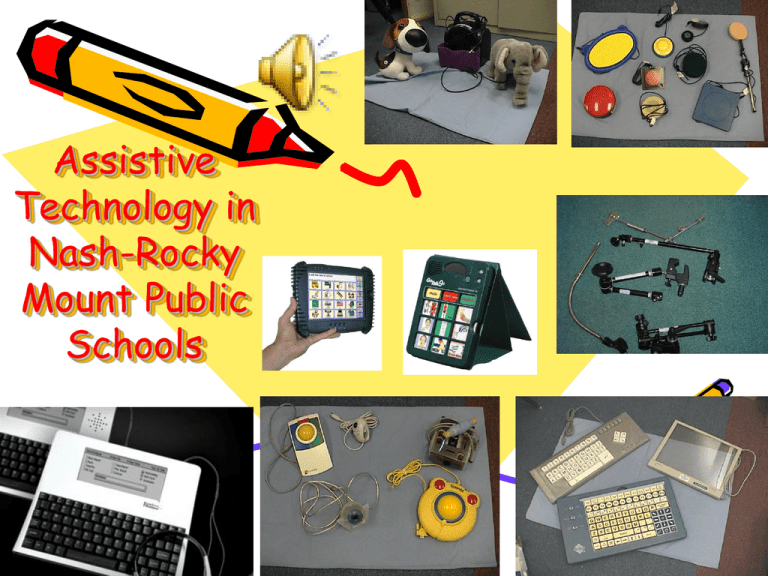
Assistive Technology in Nash-Rocky Mount Public Schools Assistive Technology (AT) is… • a generic term that includes assistive, adaptive, and rehabilitative devices and the process used in selecting, locating, and using them. AT promotes greater independence for people with disabilities by enabling them to perform tasks that they were formerly unable to accomplish, or had great difficulty accomplishing, by providing enhancements to or changed methods of interacting with the technology needed to accomplish such tasks. What are Assistive Technology Devices? The Individuals with Disabilities Education Improvement Act of 2004 (IDEA '04) defines an assistive technology device as… "any item, piece of equipment, or product system, that is used to increase, maintain, or improve the functional capabilities of a child and specifically excludes a medical device that is surgically implanted or the replacement of such device" (e.g., a cochlear implant). Assistive technology, therefore, might be something as complex as a hand-held electronic magnifying instrument or as simple as a specialized rubber pencil grip. (Authority: 20 U.S.C 1401(1) or IDEA Amendments of 2004. P.L. 108-446, 20 U.S.C. S 1400 et seq., 300.5) Categories of Assistive Technology Devices • Academic and Learning Aids: Electronic and non-electronic aids such as calculators, spell checkers, portable word processors, and computer-based software solutions that are used by a student who has difficulty achieving in his or her educational curriculum Aids for Daily Living: Self-help aids for use in activities such as eating, bathing, cooking, dressing, toileting, and home maintenance Assistive Listening Devices and Environmental Aids: Electronic and non-electronic aids such as amplification devices, closed captioning systems, and environmental alert systems that assist a student who is hard of hearing or deaf with accessing information that is typically presented through an auditory modality Categories Augmentative Communication: Electronic and non-electronic devices and software solutions that provide a means for expressive and receptive communication for students with limited speech and language Computer Access and Instruction: Input and output devices, alternative access aids, modified or alternative keyboards, switches, special software, and other devices and software solutions that enable a student with a disability to use the classroom computer Environmental Control: Electronic and non-electronic aids such as switches, environmental control units, and adapted appliances that are used by a student with a physical disability to increase his or her independence across all areas of the curriculum Categories Mobility Aids: Electronic and non-electronic aids such as wheelchairs (manual and electronic), walkers, scooters that are used to increase personal mobility Pre-vocational and Vocational Aids: Electronic and nonelectronic aids such as picture-based task analysis sheets, adapted knobs, and adapted timers and watches that are used to assist a student in completing pre-vocational and vocational tasks Recreation and Leisure Aids: Electronic and non-electronic aids such as adapted books, switch adapted toys, and leisure computer-based software applications that are used by a student with a disability to increase his or participation and independence in recreation and leisure activities Categories Seating and Positioning: Adaptive seating systems and positioning devices that provide students with optimal positioning to enhance participation and access to the curriculum Visual Aids: Electronic and non-electronic aids such as magnifiers, talking calculators, Braille writers, adapted tape players, screen reading software applications for the computer, and Braille note-taking devices that assist a student with a visual impairment or blindness to access and produce information that is typically present in a visual (print) modality (Adapted from the Assistive Technology Guidelines for Kentucky Schools, Kentucky Department of Education) What Are Assistive Technology Services? IDEA '04 defines an assistive technology service as: "any service that directly assists a child with a disability in the selection, acquisition, or use of an assistive technology device." (Authority: 20 U.S.C. 1401(1)) or IDEA Amendments of 2004, P.L. 108-446, 20 U.S. C. S 1400 et seq., 300.06) What does AT look like in our system? District Level Assistive Technology Resource Team Considers a student’s need for AT devices and services through observation, technical assistance and/or evaluation if needed. Teaches the student strategies or loans appropriate equipment to increase their capacity to participate Trains/Consults with school staff on appropriate use of AT strategies/equipment with that student Classroom Observations and Technical Assistance Team member will assist teacher in locating needed items to help meet classroom curricula goals. Items may include: augmentative communication devices, adapted keyboards, adaptive mouse, environmental control units, switches, mounting equipment, adapted toys, textbooks and a selection of special needs software. District-wide trainings Provided to EC and Related Services staff on AT-related topics as requested AT webpage Provides resources to professionals and parents http://exc.nrms.wikispaces.net/Assistive+Technology+Team 3 Levels of Service Offered Tier I Intervention: General Education Initiatives This tier focuses on challenges often faced by teachers in general classroom settings. Team members can readily share low- or no-tech options that can be easily implemented into the classroom. Consultations at this level may also serve as “teaching moments” to help general education personnel better understand the broad range and use of AAC/AT within the classroom. Tier II Intervention: AAC/AT Intermediate Consultations This tier focuses on specific students and referral concerns, thus requiring more involvement of one or more of the team members. Strategies may be no-, low- or mid-tech but should be implemented within a child’s present setting with guidance from one or more AAC/AT team members. Levels of Service Offered (cont) Tier III Intervention: AAC/AT Specialized Team Evaluations This tier focuses on the student with complex needs related to AAC/AT use. Participation of Assistive Technology Resource Team members is necessary for individualized assessment and intervention planning. In addition, other specialists may need to be included on the team to address specific areas of concerns. Strategies may be more complicated, involving mid- to high-tech devices or specific communication systems. Training of teachers, parents and related services personnel may be required and ongoing involvement of one or more team members may be necessary. Tier I:General Education Initiatives 1. Generates recommendation(s) that are easily integrated into present setting by teacher/staff using existing resources and/or common strategies Fosters general participation in the classroom Targets specific classroom concerns rather than specific student per se AT Strategies Checklist.doc 2. AAC/AT team acts as a resource to school personnel Provides in-service training as needed (to staff and administrators) Assists with classroom engineering 3. Encourages evidence-based practice; refer to RTI (consider the need for documentation) At this level, a referral to AAC/AT team may or may not occur Tier I: Making a referral Teacher completes the Tier I Classroom Referral Form and sends form to Pat Demilio at DS Johnson School. ***You may choose to complete form on line and send electronically to Pat. Forms also are located on the WIKI Webpage Assigned team member will arrange a time to meet with teacher and/or schedule a classroom observation as needed. Referral Form Tier I for Classroom Assistance.doc Tier II: Making a referral Teacher completes forms and sends to Pat Demilio, DS Johnson 1. Referral for AT screening form 2. Parent permission form 3. AT Strategies Checklist Forms also are located on the WIKI Webpage. This referral process will consist of a screening of your student’s need for Assistive Technology. The screening process may include any of the following: • Interviews with student’s classroom teacher and other members of the IEP team (such as the occupational therapist, physical therapist, speech therapist, or school psychologist). • Observation of the student performing the educational task in which he or she is having difficulty. • Introduction of simple technology options. Staff consultation to provide trial strategies. Tier II: Making a referral cont. At the conclusion of the screening, one of the team members will notify the school staff and parents of the team findings. Tier II\AT Strategies Checklist.doc Parent Permission Form.doc Referral form AAC-AT Screening.pdf Tier III Intervention: AAC/AT Specialized Team Evaluations If it is determined that a more comprehensive assistive technology evaluation is needed, an IEP meeting will be scheduled at the student’s school. One or more members of the Assistive Technology Resource Team will be present at the meeting. The IEP team will determine what further steps, if necessary, will be provided by the ATRT to best meet the student’s educational needs. NRMPS Assistive Technology Resource Team Pat Demilio, Physical Therapist, DS Johnson Elementary Cell Contact: 908-0916 PDemilio@nrms.k12.nc.us Pamela Josey, Psychologist, Fairview Early Childhood Center Cell Contact: 903-8575 PHJosey@nrms.k12.nc.us Tracey Watts, Exceptional Children’s Teacher, DS Johnson Elementary School Phone: 451-2895 tawatts@nrms.k12.nc.us Ingram Land-Deans, Speech/Language Pathologist, DS Johnson Elementary School Phone: 451-2895 ICLand-Deans@nrms.k12.nc.us Susan Henke, Speech/Language Pathologist, Nashville Elementary School Phone: 451-2877 sbhenke@nrms.k12.nc.us Lisa West, Program Specialist, Teacher Resource Center Cell Contact: 567-1077 LTWest@nrms.k12.nc.us

